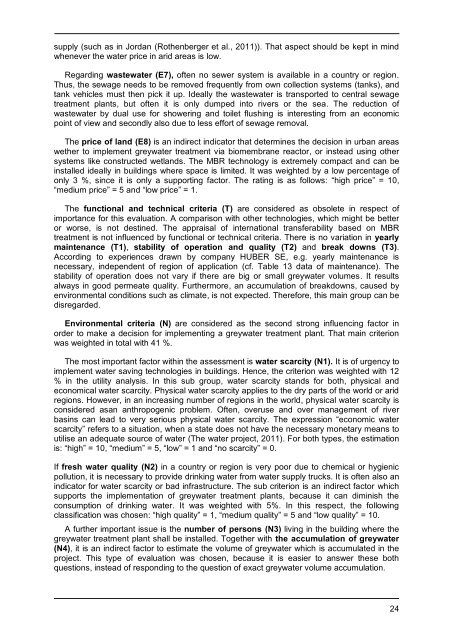An innovative greywater treatment system for urban areas ... - SuSanA
An innovative greywater treatment system for urban areas ... - SuSanA
An innovative greywater treatment system for urban areas ... - SuSanA
Create successful ePaper yourself
Turn your PDF publications into a flip-book with our unique Google optimized e-Paper software.
supply (such as in Jordan (Rothenberger et al., 2011)). That aspect should be kept in mind<br />
whenever the water price in arid <strong>areas</strong> is low.<br />
Regarding wastewater (E7), often no sewer <strong>system</strong> is available in a country or region.<br />
Thus, the sewage needs to be removed frequently from own collection <strong>system</strong>s (tanks), and<br />
tank vehicles must then pick it up. Ideally the wastewater is transported to central sewage<br />
<strong>treatment</strong> plants, but often it is only dumped into rivers or the sea. The reduction of<br />
wastewater by dual use <strong>for</strong> showering and toilet flushing is interesting from an economic<br />
point of view and secondly also due to less ef<strong>for</strong>t of sewage removal.<br />
The price of land (E8) is an indirect indicator that determines the decision in <strong>urban</strong> <strong>areas</strong><br />
wether to implement <strong>greywater</strong> <strong>treatment</strong> via biomembrane reactor, or instead using other<br />
<strong>system</strong>s like constructed wetlands. The MBR technology is extremely compact and can be<br />
installed ideally in buildings where space is limited. It was weighted by a low percentage of<br />
only 3 %, since it is only a supporting factor. The rating is as follows: “high price” = 10,<br />
“medium price” = 5 and “low price” = 1.<br />
The functional and technical criteria (T) are considered as obsolete in respect of<br />
importance <strong>for</strong> this evaluation. A comparison with other technologies, which might be better<br />
or worse, is not destined. The appraisal of international transferability based on MBR<br />
<strong>treatment</strong> is not influenced by functional or technical criteria. There is no variation in yearly<br />
maintenance (T1), stability of operation and quality (T2) and break downs (T3).<br />
According to experiences drawn by company HUBER SE, e.g. yearly maintenance is<br />
necessary, independent of region of application (cf. Table 13 data of maintenance). The<br />
stability of operation does not vary if there are big or small <strong>greywater</strong> volumes. It results<br />
always in good permeate quality. Furthermore, an accumulation of breakdowns, caused by<br />
environmental conditions such as climate, is not expected. There<strong>for</strong>e, this main group can be<br />
disregarded.<br />
Environmental criteria (N) are considered as the second strong influencing factor in<br />
order to make a decision <strong>for</strong> implementing a <strong>greywater</strong> <strong>treatment</strong> plant. That main criterion<br />
was weighted in total with 41 %.<br />
The most important factor within the assessment is water scarcity (N1). It is of urgency to<br />
implement water saving technologies in buildings. Hence, the criterion was weighted with 12<br />
% in the utility analysis. In this sub group, water scarcity stands <strong>for</strong> both, physical and<br />
economical water scarcity. Physical water scarcity applies to the dry parts of the world or arid<br />
regions. However, in an increasing number of regions in the world, physical water scarcity is<br />
considered asan anthropogenic problem. Often, overuse and over management of river<br />
basins can lead to very serious physical water scarcity. The expression “economic water<br />
scarcity” refers to a situation, when a state does not have the necessary monetary means to<br />
utilise an adequate source of water (The water project, 2011). For both types, the estimation<br />
is: “high” = 10, “medium” = 5, “low” = 1 and “no scarcity” = 0.<br />
If fresh water quality (N2) in a country or region is very poor due to chemical or hygienic<br />
pollution, it is necessary to provide drinking water from water supply trucks. It is often also an<br />
indicator <strong>for</strong> water scarcity or bad infrastructure. The sub criterion is an indirect factor which<br />
supports the implementation of <strong>greywater</strong> <strong>treatment</strong> plants, because it can diminish the<br />
consumption of drinking water. It was weighted with 5%. In this respect, the following<br />
classification was chosen: “high quality” = 1, “medium quality” = 5 and “low quality” = 10.<br />
A further important issue is the number of persons (N3) living in the building where the<br />
<strong>greywater</strong> <strong>treatment</strong> plant shall be installed. Together with the accumulation of <strong>greywater</strong><br />
(N4), it is an indirect factor to estimate the volume of <strong>greywater</strong> which is accumulated in the<br />
project. This type of evaluation was chosen, because it is easier to answer these both<br />
questions, instead of responding to the question of exact <strong>greywater</strong> volume accumulation.<br />
24

















